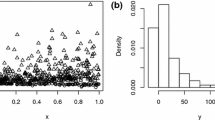Abstract
Finite mixture models arise in a natural way in that they are modeling unobserved population heterogeneity. It is assumed that the population consists of an unknown number k of subpopulations with parameters λ1, ..., λ k receiving weights p1, ..., p k . Because of the irregularity of the parameter space, the log-likelihood-ratio statistic (LRS) does not have a (χ2) limit distribution and therefore it is difficult to use the LRS to test for the number of components. These problems are circumvented by using the nonparametric bootstrap such that the mixture algorithm is applied B times to bootstrap samples obtained from the original sample with replacement. The number of components k is obtained as the mode of the bootstrap distribution of k. This approach is presented using the Times newspaper data and investigated in a simulation study for mixtures of Poisson data.
Similar content being viewed by others
References
Aitkin M. and Rubin D.B. 1985. Estimation and hypothesis testing in finite mixture models. J. R. Stat. Soc., Ser. B 47: 67–75.
Böhning D. 1995. A review of reliable maximum likelihood algorithms for semiparametric mixture models. J. Stat. Plann. Inference 47(1-2): 5–28.
Böhning D. 1999. C.A.MAN-Computer Assisted Analysis of Mixtures and Applications. Chapman and Hall.
Böhning D., Dietz E., Schaub R., Schlattmann P. and Lindsay B.G. 1994. The distribution of the likelihood ratio for mixtures of densities from the one-parameter exponential family. Ann. Inst. Stat. Math. 46(2): 373–388.
Böhning D., Dietz E. and Schlattmann P. 1998. Recent developments in computer assisted mixture analysis. Biometrics 54: 283–303.
Böhning D. and Schlattmann P. 1999. Disease mapping with a hidden structure using mixture models. In: Lawson A., Biggeri A., Böhning D., Lesaffre E., Viel J.F. and Bertollini R. (Eds.), Disease Mapping and Risk Assessment for Public Health decision making. Wiley, Chichester.
Böhning D., Schlattmann P. and Lindsay B.G. 1992. C.A.MAN-computer assisted analysis of mixtures: Statistical algorithms. Biometrics 48: 283–303.
Chen J. and Kalbfleisch J.D. 1996. Penalized minimum-distance estimates in finite mixture models. Can. J. Stat. 24(2): 167–175.
Day N. 1969. Estimating the components of a mixture of normal distributions. Biometrika 56: 463–474.
Dempster A., Laird N. and Rubin D. 1977. Maximum likelihood from incomplete data via the EM algorithm. Discussion. J. R. Stat. Soc., Ser. B 39: 1–38.
Efron B. 1982. The Jackknife, the Bootstrap and Other Resampling Plans. CBMS-NSF Reg. Conf. Ser. Appl. Math. 38.
Efron B. and Tibshirani R.J. 1993. An Introduction to the Bootstrap. Monographs on Statistics and Applied Probability, vol. 57. Chapman & Hall, New York, NY.
Eilers P. 1995. Indirect observations, composite link models and penalized likelihood. In: Seeber G., Francis B., Hatzinger R. and Steckel-Berger G. (Eds.), Statistical Modelling. Springer, Berlin, pp. 91–98.
Everitt B. and Hand D. 1981. Finite Mixture Distributions. Monographs on Applied Probability and Statistics. Chapman and Hall, London, New York.
Feng Z. and McCulloch C. 1996. Using bootstrap likelihood ratios in finite mixture models. J. R. Stat. Soc., Ser. B 58(3): 609–617.
Hasselblad V. 1969. Estimation of finite mixtures of distributions from the exponential family. J. Am. Stat. Assoc. 64: 1459–1471.
Jamshidian M. and Jennrich R.I. 1997. Acceleration of the EM algorithm by using quasi-Newton methods. J. R. Stat. Soc., Ser. B 59(3): 569–587.
Karlis D. and Xekalaki E. 1999. On testing for the number of components in a mixed Poisson model. Ann. Inst. Stat. Math. 51(1): 149–162.
Leroux B.G. 1992. Consistent estimation of a mixing distribution. Ann. Stat. 20(3): 1350–1360.
Lindsay B.G. 1983a. The geometry of mixture likelihoods: A general theory. Ann. Stat. 11: 86–94.
Lindsay B.G. 1983b. The geometry of mixture likelihoods, part II: The exponential family. Ann. Stat. 11: 783–792.
Lindsay B.G. 1995. Mixture models Theory, Geometry and Applications. NSF-CBMS Regional Conference Series in Probability and Statistics, Institute of Statistical mathematics, vol. 5, Hayward.
Lo Y., Mendell N.R. and Rubin D.B. 2001. Testing the number of components in a normal mixture. Biometrika 88(3): 767–778.
McLachlan G.J. and Basford K.E. 1988. Mixture models: Inference and Applications to Clustering. Statistics: Textbooks and Monographs, Marcel Dekker, Inc., New York etc., vol. 84, pp. 253.
McLachlan G.J. and Peel D. 2000. Finite Mixture models. Wiley, Chichester.
Mendell N.R., Thode H.C. and Finch S.J. 1991. The likelihood ratio test for the two-component normal mixture problem: Power and sample size analysis. Biometrics 47: 1143–1148.
Richardson S. and Green P.J. 1997. On Bayesian analysis of mixtures with an unknown number of components. (With discussion). J. R. Stat. Soc., Ser. B 59(4): 731–792.
Schelp F., Vivatanasept P., Sitaputra P., Sornmani S., Pongpaew P., Vudhivai N., Egormaiphol S. and Bohning D. 1990. Relationship of the morbidity of under-fives to anthropometric measurements and community health intervention. Trop Med Parasitol, pp. 121–126.
Schlattmann P. and Böhning D. 1993. Mixture models and disease mapping. Statistics in Medicine 12: 943–950.
Schlattmann P. and Böhning D. 1997. On Bayesian analysis of mixtures with an unknown number of components. Contribution to a paper by S. Richardson and P.J. Green. J. R. Stat. Soc., Ser. B 59(4): 782–783.
Seidel W., Mosler K. and Alker M. 2000. A cautionary note on likelihood ratio tests in mixture models. Ann. Inst. Stat. Math. 52(3): 481–487.
Thode H.C., Finch S.J. and Mendell N.R. 1988. Simulated percentage points for the null distribution of the likelihood ratio test for a mixture of two normals. Biometrics 44(4): 1195–1201.
Author information
Authors and Affiliations
Corresponding author
Rights and permissions
About this article
Cite this article
Schlattmann, P. On bootstrapping the number of components in finite mixtures of Poisson distributions. Stat Comput 15, 179–188 (2005). https://doi.org/10.1007/s11222-005-1307-8
Received:
Accepted:
Issue Date:
DOI: https://doi.org/10.1007/s11222-005-1307-8




